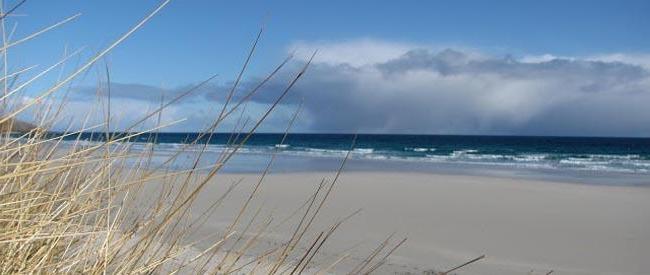Sea level rise and more frequent and intense storms have made the Outer Hebrides increasingly vulnerable to coastal flooding. Daniel Morchain recently travelled to the area to see how techniques, ancient and new, play a role in combating soil and dune erosion.
A few weeks ago I joined a team from the Oxfam Glasgow UK Poverty Programme and the University of Glasgow working on risk mitigation and adaptation to coastal erosion and sea level rise in the Outer Hebrides.
We set out to engage with residents of these sparsely populated islands and try to understand the main challenges that they are experiencing as a result of climate change and economic development pressures.
We started our trip on the islands of Barra and Vatersay, where initiatives for stabilising the dune systems have had varying degrees of success, sometimes more dependent on good decision-making from inhabitants than on climate variables.

Sand dune stabilisation is key to protecting these areas from coastal flooding and to reduce the amount of sand being blown inland by the wind.
Well-built and well-maintained sand blow fencing, together with livestock exclusion from the dunes and nearby areas are having very positive effects and giving room for marram grass to thrive and hold the dunes in place.
However, for these two measures to be more widely implemented, it is necessary to raise awareness of how the islands are threatened by climate change and what opportunities there are to tackle its effects.
Picture: sand dune erosion in the Outer Hebrides
The crofter and the lazy-bed
A ferry ride to the north took us to Eriskay, another small mountainous island, where, by chance, we came across a crofter using a centuries-old technique that supports the growing of potatoes and other vegetables in poor, sandy, rocky soil.
This part of the Outer Hebrides has become increasingly dependent on food produced elsewhere, with traditional agricultural practices dying out, to be replaced by livestock grazing.

drainage. The crofter in the photo told us that this lazy-bed or ‘run-rig’ technique pays off and he can easily grow a year’s worth of – organic – potatoes in his plot for both his family and his brother’s.
Picture: the lazy-bed technique
In addition to the climate-change project, the Oxfam Glasgow office is starting to implement an initiative to address islanders’ social issues and encourage greater self-sufficiency. It aims to reduce the high incidence of unemployment and alcohol/drug-related problems prevalent across the Outer Hebrides.
From Eriskay, we continued north to South Uist. In strong contrast to the other three islands, South Uist, and the west coast in particular, is exceptionally flat and close to sea level. This makes it susceptible to the impacts of climate change. A rising sea level, increasing winter wave activity and coastal flooding are all very immediate threats. Here the dune system is narrow and mitigating risks is likely to have a much higher cost than in, say, hilly Barra. It could also mean that, in places like South Uist, longer-term adaptation measures, such as asset
relocation, may need to be seriously considered.
Reforesting on the ‘treeless’ island
Before starting my return journey to Oxford, and as the wind in predominantly treeless South Uist was starting to get the better of me, we stopped by a house which seemed to be surrounded by nothing but flatness. However, as we entered the back garden we were welcomed by the natural shelter of young trees. The gardener explained to us that they are trying to dispel the common belief that trees no longer grow in this part of the world. A few miles away in a sheltered spot, another resident started planting trees some 30 years ago and has now reforested a few acres of land. The positive
impact of further reforestation on the soil, on assets , and not least on the well-being of the island residents – trust me – should not be underestimated. Talking to these pioneers made me think about the importance of fostering innovation as a pillar for building adaptive capacity.
During the 13-hour journey home I thought it would be worthwhile to share some of the innovations I witnessed. Not only because of their intrinsic value, but also because they illustrate the benefit of simplifying climate change adaptation and ecosystem service management concepts (though, of course, not the analysis!). A useful reminder to those of us who too often are focused on theory, far from the field.
Have your say
Have you have seen similar examples of innovative climate change adaptation? Leave your comments below.
